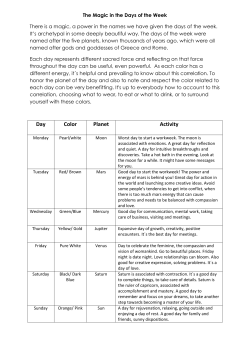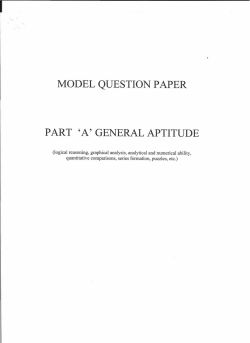
Old Final 2006
Physics 135-1 Final Exam Spring, 2006 (80 points possible) Show all work for partial credit. (Tip for entire exam: don’t forget to use ratios) 1) (5 points) In the solar system shown schematically at right, the USS Iceskater is launched tangentially to Earth’s orbit at 1.82 miles/sec relative to the Earth. The Iceskater coasts in orbit around the Sun until it intersects the orbit of Mars, also at a tangent. Earth, Mars, and the spacecraft are all rotating counterclockwise. How fast is the Iceskater moving relative to Mars, in miles/sec, when their paths intersect? Radius of Mars orbit = 1.52 X radius of Earth’s orbit Orbital speed of Earth = 18.51 miles/sec Orbital speed of Mars = 14.96 miles/sec 2) (12 points) A Physicsland® pulley that can rotate with no friction has two masses attached to it. The larger mass (M = 4 kg) is attached to the outside of the wheel at R = 1 m. The smaller mass (m = 1 kg) is attached to a small sleeve of negligible mass located near the center of the wheel at r = 0.3 m. Both are attached with massless cords that wrap perfectly around the wheel without slipping. The wheel can be assumed to be a perfect disk with a mass of M = 0.5 kg. As the larger mass falls, what is the linear acceleration of the smaller mass? 3) (5 points) I have a pendulum clock that keeps perfect time on the surface of the Earth. Then I take it to Mars, where the surface gravity is 38% that of Earth. After my battery-powered electronic wrist watch shows that an hour has passed on Mars, how much time will have passed according to the pendulum clock? Tip: this problem has nothing to do with Einstein’s relativity! 4) (15 points) An overhead view of three billiard balls on a pool table is shown at right. The masses of the balls are: m1 = 0.2 kg, m2 = 0.25 kg, m3 = 0.15 kg. Ball #1 is moving at v0 = 3 m/s along the x-axis; the other balls are stationary. Then ball #1 collides perfectly elastically between the other balls and stops. It transfers 1/2 of its momentum to ball #2 and 1/2 to ball #3. What are the velocity vectors of balls #2 and #3 after the collision (in i and j notation)? 5) (7 points) A NASA satellite with a mass of 80 kg and a moment of inertia I = 2500 kg m2 is rotating at = 0.1 rad/s. Then a meteorite with a mass of 0.1 kg and moving at 600 m/s strikes the satellite tangentially at a point 6 meters from its center of mass, and sticks. What is the new of the satellite? 6) (10 points) A balanced diet is hanging from the ceiling, as shown at right. The bars and the cords have no mass. If the distance from the cords to either end of the bars is as shown, and the food are in static equilibrium, what are m1 and m2? 27 cm 7) (10 points) In class, I often use a little model of two planets orbiting each other that consists of two spheres connected by a thin rod. Assume the following properties: Mass of larger sphere = 0.6 kg Mass of smaller sphere = 0.2 kg Length of rod = 0.5 m (the rod has no mass) What is the moment of inertia of this model (the rod and two spheres), when it is rotating freely around its center of mass? Multiple Choice (2 points each). Write your answers on this paper. _____ 8) Titan, the largest moon of Saturn, is 80% more massive than our Moon and has a radius 48% larger than our Moon. If the surface gravity on the Moon is 1.63 m/s2, what is the surface gravity on Titan? a) 2.92 m/s2 b) 1.98 m/s2 c) 2.41 m/s2 d) 0.74 m/s2 e) 1.34 m/s2 f) 1.01 m/s2 _____ 9) The following objects are rolling along the floor with equal linear velocities. They all have the same mass and radius, but different shapes. Which one has the most kinetic energy? a) hoop b) long cylinder c) thin disk d) sphere e) spoked wheel f) short cylinder _____ 10) The Earth does not remain stationary as the Moon orbits it, but instead turns around an axis that represents the center-of-mass of the Earth-Moon system. This axis passes through the Earth at a point 2/3 of the way outward from the center of the Earth. What is the moment of inertia of the Earth about this axis? You can assume that the Earth is a perfect sphere. (M = mass of Earth, R = radius of Earth). a) 0.13 MR2 b) 0.84 MR2 c) 1.5 MR2 d) 0.70 MR2 2 2 2 e) 0.25 MR f) 1.1 MR g) 0.47 MR h) 1.7 MR2 _____ 11) If you take a spinning gyroscope and drop it off a tall building (neglect air friction), it will: a) precess all the way down at constant b) precess all the way down with gradually decreasing c) not precess, but tumble randomly d) precess all the way down with gradually increasing e) not fall at all f) neither precess nor tumble, but point in one direction _____ 12) A weight attached to a spring is set into oscillation. As the weight gradually loses energy (due to friction in the spring), which of the following happens? a) amplitude decreases, frequency increases b) amplitude increases, frequency increases c) amplitude decreases, frequency is constant d) amplitude increases, frequency is constant e) amplitude decreases, frequency decreases f) amplitude increases, frequency decreases _____ 13) The Coriolis Force is: a) a fundamental force related to gravity c) a different name for centrifugal force e) responsible for the tides b) a nonexistent force postulated in the 18th century d) experienced by objects on a rotating sphere f) responsible for the precession of the Earth _____ 14) If you take a ball of radius R that is rotating very rapidly at a rate and toss it onto a flat surface with nonzero friction, what will the ball do before it begins to roll without slipping? a) skid until it has lost all of its rotational kinetic energy b) skid until its linear velocity is the same as it would be if the surface was frictionless c) skid until its linear velocity is v = R d) skid so long as the torque on it is greater than 2R times the frictional force e) skid until its angular momentum equals its linear momentum f) none of the above _____ 15) What is the gravitational force between two 100 kg football players who are 0.5 m apart? a) 2.67 X 10-6 N b) 6.67 X 10-11 N c) 6.67 X 10-7 N e) 2.67 X 10-8 N f) 1.33 X 10-10 N d) 1.34 X 10-6 N Possibly Useful Data L = r X p = rp sin = r X F = rF sin vtangent = R I = mi ri2 I = ICM + mh2 atangent L = I = I = R I (hoop) = mr2 I (disk or cylinder) = 1/2 mr2 xCM = (m1x1 + m2x2) / (m1 + m2) (spring) = (k/m)1/2 T (pendulum) = 2 (L/g)1/2 F = G m1m2 / r2 U = – G m1m2 / r g (Earth) = 9.8 m/s2 G = 6.67 X 10-11 N m2/kg2 Radius of Earth orbit = 1.496 X 1011 m Sun’s mass = 1.99 X 1030 kg 1 mile/sec = 1609 m/s I (sphere) = 2/5 mr2
© Copyright 2025












